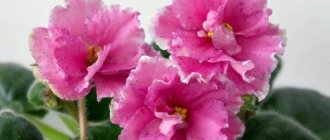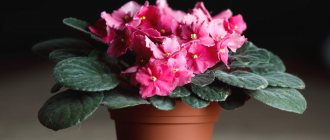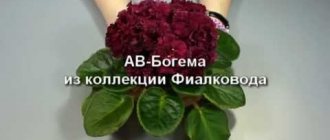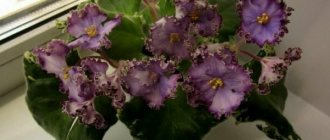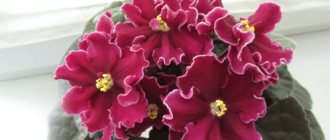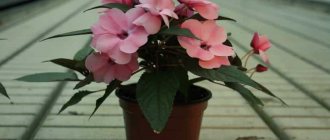What does violet look like?
Every year more and more new hybrid varieties of violets appear. They are popular due to their unpretentiousness, bright and long flowering period. Violet Wat King pea is an interesting, unusual and attention-grabbing indoor plant.
Violet VaT Tsar Peas
Plant characteristics
Description of the plant:
- The leaves, like those of other Saintpaulias, are collected in a basal rosette. At VaT Tsar Pea, it is compact and very neat.
- The flowers are white with purple “fingers” on each petal; small pink peas are scattered on the purple part.
- The size of the flowers is large - about 6 cm.
- Flowering is long lasting.
- The leaves are large, even, rich green in color with cream edging around the edges.
Violet flowers VaT Tsar Pea
Which family does it belong to?
This variety belongs to the genus Saintpaulia (often called Uzambara violet), which is part of the Gesnerieceae family.
Briefly about the history of appearance
Saintpaulias first appeared at the beginning of the 19th century. in Europe. And to date, more than 30 thousand varieties have been bred, differing in both external characteristics and nuances of care. Violet exhibitions are held annually, where new hybrids are constantly presented. The variety VaT Tsar Pea was bred relatively recently - in 2015. Like many other varieties of hybrid Saintpaulias, this one was created by the famous Ukrainian breeder Tatyana Valkova.
Interesting! Capital letters at the beginning of the variety name indicate the initials of the botanist, thanks to whom the flower was born.
Exhibition of violets in Moscow
Brief biography and achievements of the breeder Valkova Tatyana
Violet humako inches - plant features
Tatyana Valkova was born on December 13, 1971 in the Ukrainian city of Shakhtersk. She has been growing plants for two decades, and several years ago she began breeding Saintpaulias. Fame came to her very quickly, since the resulting VaT varieties were a huge success.
The war in Ukraine slowed down her work a little. However, despite all the difficulties, moving from city to city, she took with her seeds, leaves, and seedlings of violets dear to her. Friends who still had planting material also helped. Despite the fact that part of the collection was lost, Tatyana Valkova is a famous breeder, thanks to whose talent a huge number of new hybrid VaT varieties have appeared.
Tatiana Valkova
Description and characteristics of Vat varieties
Violet Ness Crinkle Blue - plant features
Tatyana Valkova became famous for her violets not only in her native country, but also in Russia and in many other countries. She regularly participates in exhibitions. The varieties she developed are in incredible demand.
Africa
Violet WaT Africa is distinguished by dark, rich purple petals, heavily corrugated along the edges. The inflorescences are located on a compact rosette of variegated leaves. It is often called African violet.
Mystic
The leaves are collected in a small neat green rosette. The flowers are large, with a large number of petals of original color. The main color of the petals is white, with patterns of pink and blue flowers randomly arranged on it, reminiscent of frosty ones.
Pulsar
The leaf rosette is small, almost invisible under the lush inflorescence. The flowers in it are large white with crimson inserts and patterns of various shapes.
Sun in the palm of your hand
The flowers are double, fluffy, white. Along the edges of the petals there is a greenish fringed edge, which turns pink towards the center of the flower. They are reminiscent of sunny, summer days, when the process takes place from the birth of the sun among lush green foliage to its rosy sunset. The leaves are deep green with white edges.
Poodle
The flowers are large, up to 7 cm in diameter, double, fluffy purple-pink in color with a blue fantasy pattern. The edge of the petals is corrugated.
Peony
Fialka vat Pion resembles a miniature copy of a lush, bright peony. Terry large flowers of raspberry color have a thin wavy white border along the edge. The basal rosette is lush, green leaves elegantly complement the bright inflorescences.
Dark wine
The flowers are large, rich wine color, with a thin white edge around the edges of the petals. The leaves are smooth and green.
Aelita
Fialka Aelita has large, double flowers of soft pink color. Along the edges of the petals there is a wavy crimson border. The rosette is bright, variegated.
Carmelita
The flowers are large stars of violet color, close to plum. There is a wavy white border along the edges. The leaves are medium-sized, dark green.
Maleficent
An incredibly beautiful and unusual variety. The flowers are densely double, ball-shaped, dark purple in color. Ideally combined with white-green lush leaves.
Several varieties of VaT violets in one pot
Fragrant violet - varieties
Breeders, in addition to traditional shades, have developed varieties of white, pink and multi-colored violets. Some varieties can bloom 2 times per season.
Let's look at the most common ones in more detail.
| Variety | Description, application | Flowers |
| Bechtles Ideal | Suitable for use in flower beds and flower beds by forcing. | Large, bright, blue-blue. The middle petal has a stripe at the base. |
| Queen Charlotte | The height of the crop is up to 20 cm. The leaf blades are round and have the shape of a rosette. In winters with little snow it can freeze, so it needs additional shelter. Blooms in May-June. | Violet, fragrant, butterfly. |
| Coeur d'Alsace | An ornamental plant with a fragrant scent. | Pink, drooping, large. |
| Red Charm | The leaves are heart-shaped, on long petioles, collected in bunches. The culture blooms in May for 25 days. | Small, purple, fragrant. |
| Foxbrook Cream | Blooms from May to September. | White with yellow center, delicate |
| Parma | A hybrid variety, up to 20 cm high. Cultivated in the 16th century in Italy, since the 19th century on an industrial scale in the form of candied fruits, liqueurs and perfumes. It blooms once a year and can have up to 20 petals. | Large, lavender or dark purple, less often white, single, 5 petals. |
| Queen Victoria | The oldest variety used for cutting. The leaves are dark green, slightly pubescent. | Rich dark pink, strewn with strokes and dots. |
Features of caring for violet king peas at home
The basic rules for caring for violets at home are approximately the same. But for each variety, especially hybrid ones, there are some peculiarities.
Temperature
What a violet looks like - description of the plant
This Saintpaulia variety prefers to be grown in a warm, but not hot, room with a temperature of about +23 °C. Also, there should be no drafts in the room where the flower grows. If these conditions are not met, the flowers will lose their brightness.
Lighting
The plant needs a large amount of diffused light. Daylight hours cannot last less than 11 hours; it is better if this figure reaches 14 hours. In winter, lighting with special phyto lamps is required.
Watering
The young plant is often watered with a small amount of water. Adult flowers are watered less often, but more moisture is required. In spring and summer, watering is carried out early in the morning. In autumn and winter, you can add water during the day. Water for irrigation should be soft, well-settled, and at room temperature.
Important! Water should not fall on the root rosette, so it is preferable to water through a tray (the main thing is not to forget to drain the remaining liquid from it). Wick watering is possible.
Wick watering of violets
Spraying
Spraying is contraindicated. Since the leaves are very delicate, they do not tolerate moisture. But every month you can give the plant a refreshing shower, after which you need to ensure that the above-ground part of the plant remains dry. If some of the moisture is not glass, you must remove it yourself.
Humidity
There are no special complaints about air humidity, but it should not be below 50%. If the climate is too dry, you cannot spray the flower or the space around it - the leaves have a negative attitude towards moisture. To humidify the air, you can place a tray with wet expanded clay or a vessel with water next to it.
Priming
Ready-made soil for Saintpaulias or violets is best. But you can make your own soil mixture. To do this, take 3 parts of leaf soil, 2 parts of turf and coniferous soil, and 1 part of peat. It is also necessary to add perlite, vermiculite or sphagnum. They will help make the substrate looser.
Important! Sphagnum moss is ideal because it also slightly acidifies the soil.
Feeding
Fertilizer application will be needed in spring and summer, during the period of active development and flowering. At other times of the year, this procedure is not necessary. During the flowering period, potassium-phosphorus fertilizers will be needed, and nitrogen fertilizers will be needed to gain green mass. Many ready-made complex fertilizers are sold for violets.
Lovers of violets: care, watering, flowering
February 02, 2022 07:55 Photo: design-homes.ru
Indoor violets (Saintpaulias) are, without a doubt, the most popular and favorite flowers of many gardeners and housewives. In many countries, violet blossoms mean the arrival of spring. Their inflorescences, although small, are delicate and graceful, reminiscent of our unity with nature. Indoor Saintpaulias do not take up much space on window sills, are not a source of allergies and are completely unpretentious. You just need a little love and knowledge of her preferences for these cute flowers to grow and continuously bloom in your home.
Plant flowers in clay pots.
It is in such containers that violets develop best.
Fill them with high-quality store-bought soil mixture or nutritious soil made at home. ⠀ Don't let violets grow.
There should not be too many leaves on one stem.
When there are more than seven leaf plates on the surface of Saintpaulia, they must be removed. Otherwise, the plant will spend all its vitality on strengthening the foliage. This will slow down the process of buds appearing. Excess flowers are removed not with a knife or scissors, but by hand. ⠀ Water the plants regularly.
This must be done daily.
To make violets bloom faster, they are watered with warm water. Boiling water cannot be used in this case. Otherwise, you can harm your flowers. ⠀ Feed the flowers.
If there is a need to quickly add a large amount of nutrients to the soil, it is worth using foliar fertilizers.
In other cases, root fertilizers are used. After applying fertilizers, the soil in the pot must be watered with warm, settled water. Miniature varieties of violets are watered with a solution diluted with warm water. In winter, fertilizing is reduced to a minimum. ⠀ Use homemade fertilizers.
In between feedings, you can use home remedies to improve the condition of the plants. Used tea leaves have a good effect on the condition of the soil. It should be understood that midges often breed in such an environment. Therefore, the tea leaves must be promptly removed and replaced with a new one. Flowers that prefer acidic soil can be fed with coffee grounds. Watering flowers with sugar syrup is also allowed. It is prepared by diluting two teaspoons of sugar in one glass of water. Such home remedies work just as well as store-bought ones. Therefore, they can be used to make plants more beautiful.
⠀
Loosen the soil.
This must be done monthly. Loosen the soil carefully, trying not to damage the violet roots. The violet's root system is delicate, so one wrong move can lead to the death of the plant.
Clean the plant from dust.
Even if the house is regularly cleaned, dust still constantly settles on the leaves.
Therefore, it is important to clean plants from dust. It is not recommended to wash them under running water. This can cause burns on the greens. To avoid this, violet foliage is periodically wiped with napkins or pieces of soft cloth. This must be done carefully so as not to injure the delicate foliage. ⠀ Remove dried leaves and buds.
This will improve the condition of the plant, as well as increase the number of flowers on it.
They do this on a regular basis. ⠀ Use growth stimulants.
They are used after replanting flowers if the soil is poor enough. As a rule, the soil is treated with preparations such as Epin or Zircon. Always use them according to the instructions. ⠀ In addition, it is worth understanding that violets bloom most abundantly at the age of 2-4 years. Buds on older plants appear much less frequently. Therefore, you need to regularly update your collection of violets. In this case, the plants will always delight people with their abundant flowering.
When and how does it bloom
The flowering of the violet VaT Tsar Pea is bright and spectacular.
The calyx of the flower consists of 5 sepals, the flowers are simple with 5 petals, bisexual. The shape of the flowers is a rounded star.
Flowering period
Most often, active flowering of violets of this variety occurs in the second half of spring and ends at the end of September. However, with proper care, you can make this period almost year-round. The plant does not require too long a rest period.
Changes in care during the flowering period
During the flowering period, you should avoid applying nitrogenous fertilizers, and focus on those rich in phosphorus and potassium.
Important! It is necessary to protect the flower from direct sunlight, while ensuring long daylight hours.
Features of the view
There are about 20 thousand varieties among Saintpaulias.
The creator of the violet wasp is considered to be the US breeder Jimmy Dates. This variety is unusual in the shape of its flowers, which from a distance resemble a flying insect. The flower is similar to a cyclamen, consists of two upper short petals bent back, the three lower petals look in different directions, almost dissected, which is not typical for Gesneriaceae. Sometimes the petals are curled into a tube or do not open at all. The color of the flowers is not multifaceted. Common wasps are white, pink, blue-violet or lilac in color. There is also a type of chimera, variegated, green-flowered and yellow-colored. The wasp violet has special leaves. In ordinary varieties, the leaf itself is attached at the end of the leaf petiole, but in our variety, at the place where the leaf is attached to the petiole, there are two leaf-shaped processes like ears. These are stipules that are adjacent to the leaf blade and twisted inward. Saintpaulia also has ordinary leaves, even and symmetrical.
In 1964, AVSA registered Dates' selection of wasps, Pink Wasp and Spootnik. Many of the varieties bred by this breeder have been lost to date. Common types of violet wasps include blue Spootnik, Blue Tail Fly, Hood Wink, Dave Masterson Wasp, The Martian, Nymph Fly. Pink varieties - Will-o-the-Wasp, Pink Fly, Lunar Lily, Aeolian Wasp. There are very few white, red and two-color species.
How Saintpaulia vat king pea propagates
For this type of violet, there are two possible methods of propagation - seed and cuttings. The seed method is used less frequently, since seeds of this variety are almost impossible to find on sale.
Self-collection and subsequent sowing of seeds will not bring the desired result. Daughter plants will not retain the properties of the mother plant. Of course, you will get nice flowers, but it will no longer be the Tsar Pea.
Cuttings are carried out as follows:
- Leaves that have not fully grown, but have already reached ¾ of the standard length, are selected as cuttings. Their petiole is cut at a height of 4 cm.
- The cuttings are planted in boxes filled with loose soil mixture, which is covered with a layer of clean river sand on top. After planting, the substrate is watered abundantly.
- Planting depth is 2-3 cm, the distance between leaves is at least 2 cm, and between rows is about 6 cm.
Important! Plants are kept in a shaded, warm room for a month and watered abundantly.
After a month, watering is reduced to 2 times a week and wait until each cutting reaches a diameter of approximately 3 cm. This may take up to six months. After this, picking is carried out in small cups with a capacity of about 250 ml, filled with nutritious soil. Gradually a rosette of leaves appears.
When the size of the rosette reaches 3-5 cm, the violets are transplanted into separate pots. In a couple of months they will begin to bloom.
Rooted violet leaves
Fragrant violet - cultivation, care
The plant is unpretentious, loves light soil, the composition as close as possible to forest soil, with abundant humus. Garden violet placed in partial shade can bloom longer and retains the bright color of its leaves than those located in sunny areas.
For planting in flower beds, use a mixture of compost, peat and sand, taken in equal quantities.
The best method of propagation is to root young shoots with internodes.
They are separated from adult plants, including those that grow in the wild, and transferred to the garden plot. You can get flowers by growing them from seeds, but this method is suitable for experienced gardeners, since the seed material dries out quickly and requires special preparation: stratification, soaking, germination and obtaining seedlings.
https://www.youtube.com/watch?v=C6b9au-yh94
Caring for the crop consists of regular watering, weeding and thinning. The fragrant violet multiplies very quickly, displacing other species from the space allocated for it. Therefore, it is recommended to periodically remove the sprouts that have formed.
In dry weather, leaves may suffer from spider mites, which begin to become active during this period. Therefore, it is important to follow agricultural techniques: prevent the soil from drying out and sprinkle it.
For good growth and flowering, it is necessary to apply leaf compost two to three times a season, as well as special mineral fertilizers for flowers.
Transplantation after purchase and during reproduction
After purchase, the plant must undergo a quarantine period. It lasts from 2 weeks to 2 months. The flower must be isolated from other plants, since after leaving the store it can become a carrier of dangerous infections. If it is not possible to keep it in a separate room, you can cover it with a plastic bag for a while.
Transplantation is carried out using the transshipment method. At the same time, the earthen lump and violet roots are inspected; it is better to disinfect the soil. When transplanting during propagation, the plant is also removed along with the earthen clod and transplanted into a new, more spacious container.
Possible problems in growing
The main problems when growing the VaT Tsar Peas variety are similar to those that arise when caring for other varieties of indoor Saintpaulias.
Problems with leaves
The following problems are possible:
- Limp, drooping leaves indicate that the flower has not been watered for a long time. You cannot immediately fill the violet with a large amount of water. After drying out, watering is carried out gradually, starting with small doses, which gradually increase and reach the normal level. This problem with leaves also occurs when violets are overwatered.
- Salt deposits on the leaves can be eliminated using sphagnum moss, which is laid on the top layer of soil.
- Leaves become smaller because the soil is not rich enough in nutrients. The best option is to transplant into a new substrate.
- Leaves curl due to heat or overheating. The flower should be placed in a shaded, cooler room. Damaged parts can be removed; replanting into new soil may be required.
- If the cuttings stretch out, it means they do not have enough light.
- Spots on the leaves occur due to drops of water that hit the leaves or cold weather.
These are the main difficulties that can arise with leaves. If you follow the rules of caring for the plant, they will not arise.
Pests
The most common pests that bother Saintpaulia are:
- mealybug;
- mites;
- aphid;
- nematodes.
If signs of the appearance of these insects are detected, urgent treatment with insecticides will be required. But you need to be careful with their dosage, since violet is very sensitive to the addition of chemical elements.
Diseases
The most common diseases:
- root and stem rot;
- leaf rust;
- powdery mildew;
- late blight;
- fusarium;
- vascular bacteriosis.
Important! To combat diseases, it is necessary to identify the causes of their occurrence. It will require replanting into new soil, removing all infected parts of the plant, and a quarantine period spent in isolation from other plants.
Signs of improper care
Improper care is instantly reflected on Saintpaulias, depending on excess or lack of lighting, overflow or prolonged drought, temperature and proper humidity. If at least one of these rules is violated, the leaves and flowers become faded, drooping, and change color. Flowering may not occur at all. Therefore, you need to monitor sensitive violets as carefully as possible.
Violet VaT Tsar Peas is an interesting, original hybrid variety. Its flowering is spectacular and long-lasting, the flowers are large and bright with an unusual color. The plant will take its rightful place on the windowsill of any gardener and will decorate his collection.
Violet Senk`s Alchemy Antique Bells or Antique bells
Mysterious variety Senk`s Alchemy Antique Bells.
Miniature variety, heart-shaped foliage. Extended. Easily forms an even rosette . The flowers are simple yellow bells with a wavy edge and a darker center. Sometimes purple streaks appear in the middle of the bell. If the bell is fully opened, then it is a sport.
This is a fallen variety, the flowers do not last long , they flourish quickly. But a lot of buds are formed, the bells bloom one by one and the effect of continuous flowering occurs. Peduncles:
- Sturdy;
- Tall.
This Saintpaulia has very strong flower stalks.
A large number of buds are formed on each of them. One flower lasts about two weeks.
The bush needs constant updating. Two or three flowerings, and the plant must be replanted or renewed , otherwise a tall palm grows and the color of the buds becomes less saturated. He also often turns to sports. Blue stripes or spots appear.
The presented violet has sport.
The official sport is Our Crew , a chimeric sport registered by the House of Violet.
Chimeric sport Our Crew.
Reviews
Inna, Moscow. “The rosette is smooth, the bells are yellowish. The plant looks like a toy. It develops very quickly and produces early flowering. Produces a large number of flower stalks with buds. But the flowers fall off, and if you don’t replant them, they take on an ivory hue.”
Mila, Voronezh region. “Compact rosette, gramophone flowers. A completely unpretentious variety.”



